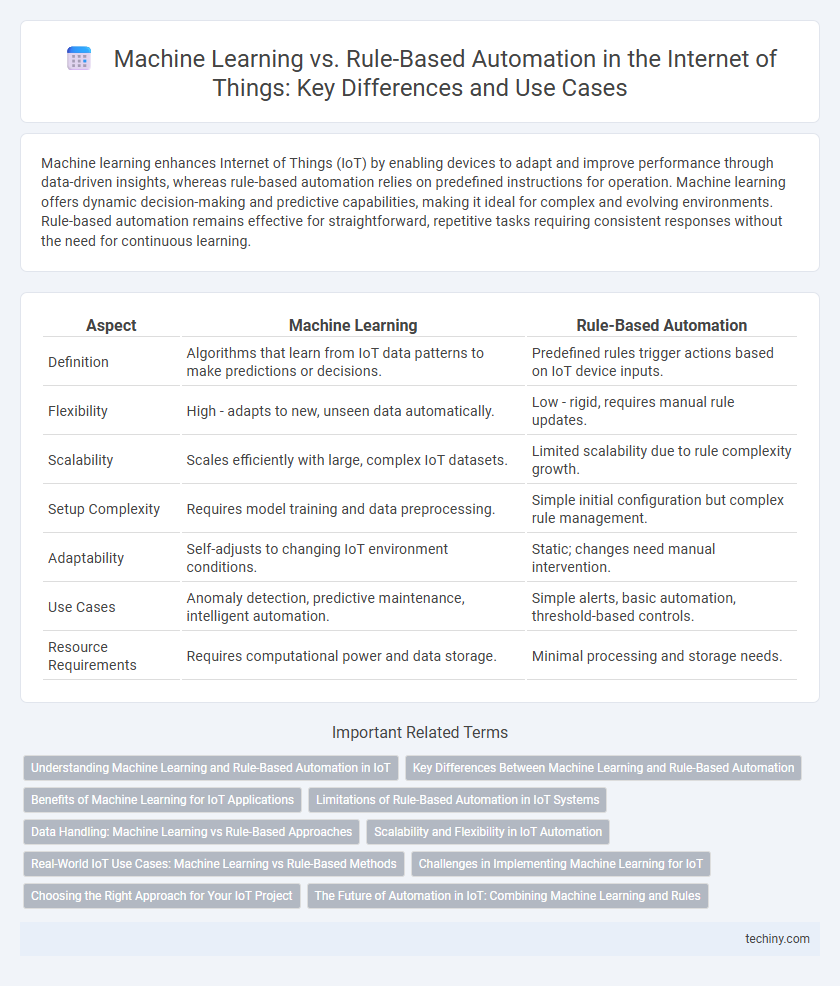Machine learning enhances Internet of Things (IoT) by enabling devices to adapt and improve performance through data-driven insights, whereas rule-based automation relies on predefined instructions for operation. Machine learning offers dynamic decision-making and predictive capabilities, making it ideal for complex and evolving environments. Rule-based automation remains effective for straightforward, repetitive tasks requiring consistent responses without the need for continuous learning.
Table of Comparison
| Aspect | Machine Learning | Rule-Based Automation |
|---|---|---|
| Definition | Algorithms that learn from IoT data patterns to make predictions or decisions. | Predefined rules trigger actions based on IoT device inputs. |
| Flexibility | High - adapts to new, unseen data automatically. | Low - rigid, requires manual rule updates. |
| Scalability | Scales efficiently with large, complex IoT datasets. | Limited scalability due to rule complexity growth. |
| Setup Complexity | Requires model training and data preprocessing. | Simple initial configuration but complex rule management. |
| Adaptability | Self-adjusts to changing IoT environment conditions. | Static; changes need manual intervention. |
| Use Cases | Anomaly detection, predictive maintenance, intelligent automation. | Simple alerts, basic automation, threshold-based controls. |
| Resource Requirements | Requires computational power and data storage. | Minimal processing and storage needs. |
Understanding Machine Learning and Rule-Based Automation in IoT
Machine learning in IoT enables devices to learn from data patterns and improve decision-making without explicit programming, enhancing adaptability and efficiency. Rule-based automation relies on predefined conditions and scripts to trigger specific actions, offering predictability but limited flexibility in dynamic environments. Combining machine learning with rule-based systems can optimize IoT performance by leveraging continuous learning and predefined operational guidelines.
Key Differences Between Machine Learning and Rule-Based Automation
Machine learning in IoT leverages data-driven algorithms to identify patterns and make autonomous decisions without explicit programming, adapting over time for improved accuracy. Rule-based automation depends on predefined conditions and fixed logic, executing specific actions when certain criteria are met, lacking flexibility in dynamic environments. Key differences include adaptability, with machine learning offering continuous learning capabilities, whereas rule-based systems deliver predictable and transparent operations ideal for static scenarios.
Benefits of Machine Learning for IoT Applications
Machine learning enhances IoT applications by enabling real-time data analysis and adaptive decision-making without relying on predefined rules. This approach improves accuracy in pattern recognition, anomaly detection, and predictive maintenance, leading to optimized performance and reduced operational costs. Unlike rule-based automation, machine learning models continuously evolve through data exposure, allowing IoT systems to handle complex, dynamic environments effectively.
Limitations of Rule-Based Automation in IoT Systems
Rule-based automation in IoT systems struggles with scalability and adaptability due to rigid, predefined rules that cannot handle dynamic or unforeseen scenarios effectively. Such systems often fail to process complex, high-dimensional data generated by IoT devices, leading to limited decision-making capabilities. Machine learning overcomes these limitations by enabling data-driven insights and real-time learning from diverse IoT datasets, improving accuracy and system responsiveness.
Data Handling: Machine Learning vs Rule-Based Approaches
Machine learning in Internet of Things (IoT) excels at processing vast amounts of unstructured data by identifying patterns and adapting to new information, enabling predictive analytics and real-time decision-making. Rule-based automation relies on predefined logic and structured data inputs, making it efficient for straightforward tasks but limited in handling complex, evolving datasets. Machine learning models continuously improve with incoming data, whereas rule-based systems require manual updates to accommodate changing conditions.
Scalability and Flexibility in IoT Automation
Machine learning in IoT automation enables scalable solutions by continuously adapting to new data patterns without manual intervention, unlike rule-based automation which requires explicit rule updates for each scenario. This adaptability enhances flexibility, allowing IoT systems to handle complex, dynamic environments efficiently. Consequently, machine learning-driven IoT automation supports exponential growth and diverse application needs better than static rule-based approaches.
Real-World IoT Use Cases: Machine Learning vs Rule-Based Methods
Machine learning enhances IoT by enabling adaptive data-driven decision-making, exemplified in predictive maintenance for manufacturing and anomaly detection in smart grids. Rule-based automation excels in predefined scenarios like HVAC control and simple alerting systems, where consistent, repeatable actions are necessary. Combining both approaches often yields optimal IoT solutions by balancing flexibility with deterministic reliability.
Challenges in Implementing Machine Learning for IoT
Implementing machine learning in IoT faces significant challenges such as data heterogeneity, limited computational resources on edge devices, and ensuring real-time processing capabilities. Unlike rule-based automation that relies on predefined instructions, machine learning models require large volumes of labeled data for training and continuous updates to maintain accuracy amid dynamic environments. Addressing these issues demands advanced algorithms optimized for low-power IoT devices and robust data management strategies to harness reliable insights from diverse sensor networks.
Choosing the Right Approach for Your IoT Project
Machine learning enables IoT systems to adapt and improve through data-driven models, making it ideal for complex, dynamic environments requiring pattern recognition and predictive analytics. Rule-based automation suits scenarios with well-defined, static conditions and straightforward decision-making processes, ensuring predictable and easy-to-maintain IoT operations. Evaluating factors like project complexity, data availability, and scalability helps determine whether machine learning or rule-based automation best aligns with your IoT objectives.
The Future of Automation in IoT: Combining Machine Learning and Rules
The future of automation in IoT lies in integrating machine learning algorithms with rule-based systems to enhance adaptability and precision. Machine learning enables dynamic data-driven decision-making, while rule-based automation ensures consistency and compliance with predefined standards. This hybrid approach optimizes device performance, reduces errors, and accelerates real-time response across connected IoT networks.
Machine learning vs Rule-based automation Infographic

 techiny.com
techiny.com